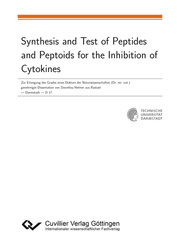| Departments | |
|---|---|
| Book Series (96) |
1378
|
| Nachhaltigkeit |
3
|
| Gesundheitswesen |
1
|
| Humanities |
2364
|
| Natural Sciences |
5406
|
| Mathematics | 229 |
| Informatics | 319 |
| Physics | 980 |
| Chemistry | 1363 |
| Geosciences | 131 |
| Human medicine | 243 |
| Stomatology | 10 |
| Veterinary medicine | 108 |
| Pharmacy | 147 |
| Biology | 835 |
| Biochemistry, molecular biology, gene technology | 121 |
| Biophysics | 25 |
| Domestic and nutritional science | 45 |
| Agricultural science | 1004 |
| Forest science | 201 |
| Horticultural science | 20 |
| Environmental research, ecology and landscape conservation | 148 |
| Engineering |
1793
|
| Common |
98
|
|
Leitlinien Unfallchirurgie
5. Auflage bestellen |
|
Advanced Search
Synthesis and Test of Peptides and Peptoids for the Inhibition of Cytokines (English shop)
Dorothea Helmer (Author)Preview
Table of Contents, PDF (50 KB)
Extract, PDF (480 KB)
Die vorliegende Arbeit beschreibt die Identifizierung und Charakterisierung von Chemokin-bindenden Strukturen aus der Klasse der Peptide und Peptoide. Im ersten Teil wurde durch flexibles Protein-Protein Docking ein Modell des Rezeptor-Ligand-Komplexes des Chemokins CXCL8 mit seinem Rezeptor CXCR1 entwickelt, welches die in der Literatur vorgeschlagene Möglichkeit einer Wechselwirkung zwischen dem ELR Motiv von CXCL8 und den extrazellulären Domänen von CXCR1 bestätigt. Auf der Basis dieses Modells wurde durch Verknüpfung von zwei Ausschnitten aus der Sequenz von CXCR1 ein Peptid entworfen, welches CXCL8 mit einer Affinität von 500 nM bindet und die durch CXCL8 induzierte Migration von humanen neutrophilen Granulozyten inhibiert. Im zweiten Teil der Arbeit wurden one-bead-one-compound (OBOC) Bibliotheken von Peptoiden auf TentaGel Harz systematisch auf ihre Fähigkeit zur Bindung an fluoreszenzmarkiertes CXCL8 untersucht. Durch Optimierung der Screening-Parameter und Vereinfachung des Auswertungsprozesses mittels Analyse von fluoreszenzmikroskopisch erhaltenen Mischkanalbildern wurden 18 Peptoidsequenzen identifiziert, die CXCL8 mit mikromolaren Affinitäten binden.
This work describes the identification and characterization of chemokine ligands of the compound classes of peptides and peptoids. In the first part of this work, a model of the receptor-ligand complex of the chemokine CXCL8 and its receptor CXCR1 was generated by flexible protein-protein docking. The model confirmed the possibility of an interaction between the ELR motif of CXCL8 and the extracellular domains of CXCR1, which was previously suggested by the literature. Based on this model, a peptide was designed by connecting two sequence motifs of CXCR1 in an attempt to mimic the receptor binding site. The peptide was determined to bind CXCL8 with an affinity of 500 nM and was found to inhibit CXCL8-induced migration of human neutrophil granulocytes. In the second part of this work, one-bead-one-compound (OBOC) libraries of peptoids on TentaGel resin were tested for their ability to bind fluorescently labelled CXCL8. By optimising screening parameters and by analysing microscopy images of the resin in two different fluorescence channels, 18 peptoids were identified that bind CXCL8 with micromolar affinities.
| ISBN-13 (Hard Copy) | 9783954049844 |
| ISBN-13 (eBook) | 9783736949843 |
| Final Book Format | A5 |
| Language | English |
| Page Number | 206 |
| Lamination of Cover | glossy |
| Edition | 1. Aufl. |
| Publication Place | Göttingen |
| Place of Dissertation | Darmstadt |
| Publication Date | 2015-04-29 |
| General Categorization | Dissertation |
| Departments |
Chemistry
Organic chemistry |
| Keywords | Chemokine, Interleukin-8, CXCL8, CXCR1, CXCL8-binding peptide, CXCL8-binding peptoid, OBOC Screening |








